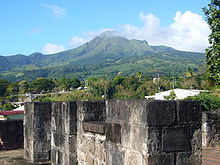Saint-Pierre Theater (Martinique)
The theater of Saint-Pierre in the French overseas department of Martinique ( Antilles ), also known as La Comédie or Salle de la Comédie , was a theater , opera , ballet and concert hall on Martinique built towards the end of the 18th century . The name of its architect is not known. The luxury of this largest theater in Martinique, built according to the plans of the Grand Théâtre of the then slave transhipment port in Bordeaux and inaugurated on December 16, 1786, testifies to the wealth of Saint-Pierre, the most important city on the island from an economic and cultural point of view before 1902.
The building, which was damaged several times by natural disasters and rebuilt, finally had a classicist facade. It was closed in 1901 for economic reasons and largely destroyed on May 8, 1902 by the glowing cloud of the volcanic eruption of the Montagne Pelée . Its as historique monument classified ruin is owned by the municipality and is since 12 December 1996 under monument protection .
history
The Salle de la Comédie programmed performances by local theater troupes or those who had traveled from the mother country , took on the great prom of the Carnival of Saint-Pierre, which is known throughout the Caribbean , and also served as a meeting place, including for political meetings.
The theater was first significantly damaged by the cyclone of 1813, restored and reopened on December 31, 1817 with a completely rebuilt auditorium. In the years 1831–1832 extensive renovations followed, which were again damaged by a cyclone. The glowing cloud of the Pelée eruption destroyed the Salle de la Comédie in 1902 except for a few remains of the outside area and various elements of the basement.
architecture
Before the catastrophe of 1902, there was a spacious open staircase in front of the building. The steps of a first, straight staircase led to a landing from which two symmetrical, curved staircases led to the level of the entrance hall. The area between these last two stairs was adorned by a semicircular wall arch flanked by pilasters with a fountain.
The classicist seven- yoke facade had round-arched openings in the basement , and rectangular Parisian windows with richly decorated wrought-iron window parapets on the upper floor. The conclusion was formed by an architrave , the cornice and a parapet . From the entrance hall, the designed with marble and was two rows of pillars provided vestibule accessible, the floor-spaces have been achieved by the central part. The side sections housed the stairwells with the stairs to the tiers.
The hall, completed in 1817, was designed in the shape of a horseshoe based on the Italian model and had 800 (1000 according to other sources) seats. Anchored on a sloping floor Orchestra - and parquet squares surrounding a rank of floor boxes ( baignoires ), it rose three rows of boxes , one of which served the third the "free" coloreds, and a gallery for the slaves. On either side of the orchestra pit there was a box of honor framed by caryatids .
ruins
The remains of this theater that still exist today are:
- at the street level, the rails that opened and closed the wrought-iron grille;
- behind it parts of the flight of stairs and the fountain with the bronze gargoyles in the shape of dolphins;
- Traces of the pillars of the entrance hall;
- the floor of the vestibule covered with black and white marble slabs;
- the horseshoe-shaped, sloping floor of the auditorium and parts of the ground floor box.
The orchestra pit and the stage are also recognizable.
literature
- Maurice Nicolas: Les grandes heures du théâtre de Saint-Pierre , Imp.Berger-Bellepage, Fort-de-France 1974
Web links
- “La Comédie” theater in Saint-Pierre (Martinique) in the Mérimée database on the www.culture.fr portal of the French Ministry of Culture
- “La Comédie” theater in Saint-Pierre (Martinique), photograph taken before 1902 in the Martinique Events and Travel Guide
Footnotes
- ↑ See www.culture.fr ( page no longer available , search in web archives ) Info: The link was automatically marked as defective. Please check the link according to the instructions and then remove this notice. Website of the French Ministry of Culture
Coordinates: 14 ° 44 ′ 49 " N , 61 ° 10 ′ 33.2" W.


